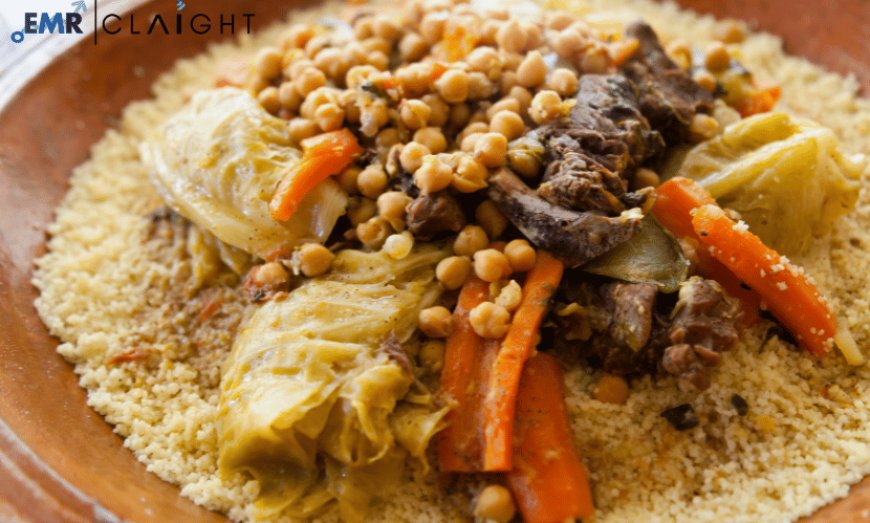Couscous Market Report and Forecast 2024-2032: Growth Driven by Health Trends, Culinary Innovation and Convenience
The global couscous market is on a growth trajectory, driven by increasing health consciousness, rising demand for convenient meal solutions, and the expanding appreciation of global cuisines.

According to the report by Expert Market Research (EMR), the global couscous market is projected to experience a steady growth rate of 3.5% CAGR from 2024 to 2032. This growth is driven by increasing consumer awareness of healthy eating habits, the rising popularity of Mediterranean and Middle Eastern cuisines, and the expanding availability of couscous in various food segments. The market is anticipated to expand significantly by 2032 as couscous gains traction as a versatile, nutritious, and convenient food option.
Couscous, a traditional North African dish made from steamed crushed wheat, has evolved beyond its cultural roots to become a globally appreciated staple. Its versatility in both savory and sweet dishes, ease of preparation, and health benefits contribute to its growing popularity. As consumers seek healthier, quick-to-prepare meals, couscous fits the bill with its high nutritional value, low fat content, and ability to absorb various flavors and ingredients.
The increasing urbanization and busy lifestyles of consumers worldwide are pivotal in the couscous market’s growth. Urban dwellers are increasingly looking for convenient meal solutions that do not compromise on nutrition or taste. Couscous, being quick to cook and adaptable to different recipes, meets this demand effectively. Additionally, the expanding trend of global culinary exploration has introduced couscous to new markets, further fueling its adoption.
Get a Free Sample Report with Table of Contents: https://www.expertmarketresearch.com/reports/couscous-market/requestsample
Innovation in the couscous market is also a significant driver of growth. Companies are investing in developing new varieties and flavors of couscous to cater to diverse consumer preferences. The introduction of organic and gluten-free options has further enhanced the appeal of couscous to health-conscious consumers. Retailers are increasingly offering couscous in various formats, including pre-seasoned and ready-to-cook versions, to cater to different culinary needs and preferences.
As the market grows, there is a notable emphasis on sustainability and ethical sourcing. Consumers are becoming more conscious of the environmental impact of their food choices, leading to a demand for sustainably sourced couscous. Companies that prioritize eco-friendly practices and transparent supply chains are likely to gain a competitive edge.
Read Full Report with Table of Contents: https://www.expertmarketresearch.com/reports/couscous-market
Market Segmentation
The couscous market can be segmented based on type, distribution channel, and region.
Market Breakup by Type
- Traditional Couscous: Made from durum wheat and often found in North African and Middle Eastern cuisine.
- Instant Couscous: Pre-cooked couscous that requires minimal preparation.
- Whole Wheat Couscous: Made from whole grain wheat, offering higher nutritional value.
- Gluten-Free Couscous: Made from alternative grains like rice or corn to cater to gluten-intolerant individuals.
Market Breakup by Distribution Channel
- Supermarkets/Hypermarkets: The largest distribution channel, providing consumers with a wide range of couscous options.
- Specialty Stores: Stores focusing on health foods and ethnic products, offering diverse couscous varieties.
- Online Retail: Growing in popularity due to convenience and the ability to offer a broad selection of couscous products.
- Convenience Stores: Offering ready-to-eat and instant couscous options for on-the-go consumers.
Market Breakup by Region
- North America: Increasing adoption of Mediterranean diets and the presence of diverse culinary preferences drive market growth.
- Europe: Significant consumer base for couscous, particularly in countries with strong Mediterranean influence such as France and Italy.
- Asia Pacific: Rising middle-class population and growing interest in international cuisines are contributing to market expansion.
- Latin America: Gradual increase in the adoption of couscous as part of a varied diet.
- Middle East and Africa: Traditional region for couscous with established consumption patterns and increasing interest in global food trends.
Competitive Landscape
The EMR report examines the market shares, production capacities, investments, and strategic developments of key players in the global couscous market. Some of the major companies highlighted in the report include:
- Pasta Zara S.p.A.: Known for its extensive range of pasta and couscous products, Pasta Zara is a significant player in the global market.
- Horizon Milling: A key player in the grain processing industry, providing couscous and other grain products.
- Goya Foods, Inc.: Offers a variety of couscous options and has a strong presence in the North American market.
- Ariat LLC: Specializes in couscous and other ethnic food products, with a focus on quality and innovation.
- Bob's Red Mill Natural Foods, Inc.: Known for its organic and whole-grain products, including couscous.
- The Hain Celestial Group, Inc.: Provides a range of organic and natural couscous products.
- Couscous Company: A dedicated couscous producer known for its diverse product offerings.
These companies are focusing on expanding their product portfolios, enhancing distribution networks, and engaging in strategic partnerships to strengthen their market position. The competitive landscape is marked by a focus on innovation, sustainability, and meeting evolving consumer preferences.
The global couscous market is on a growth trajectory, driven by increasing health consciousness, rising demand for convenient meal solutions, and the expanding appreciation of global cuisines. The market’s future looks promising, with opportunities for innovation, diversification, and sustainability driving its evolution. Companies that adapt to consumer trends, invest in product development, and prioritize ethical practices are likely to lead the market and shape its future.












